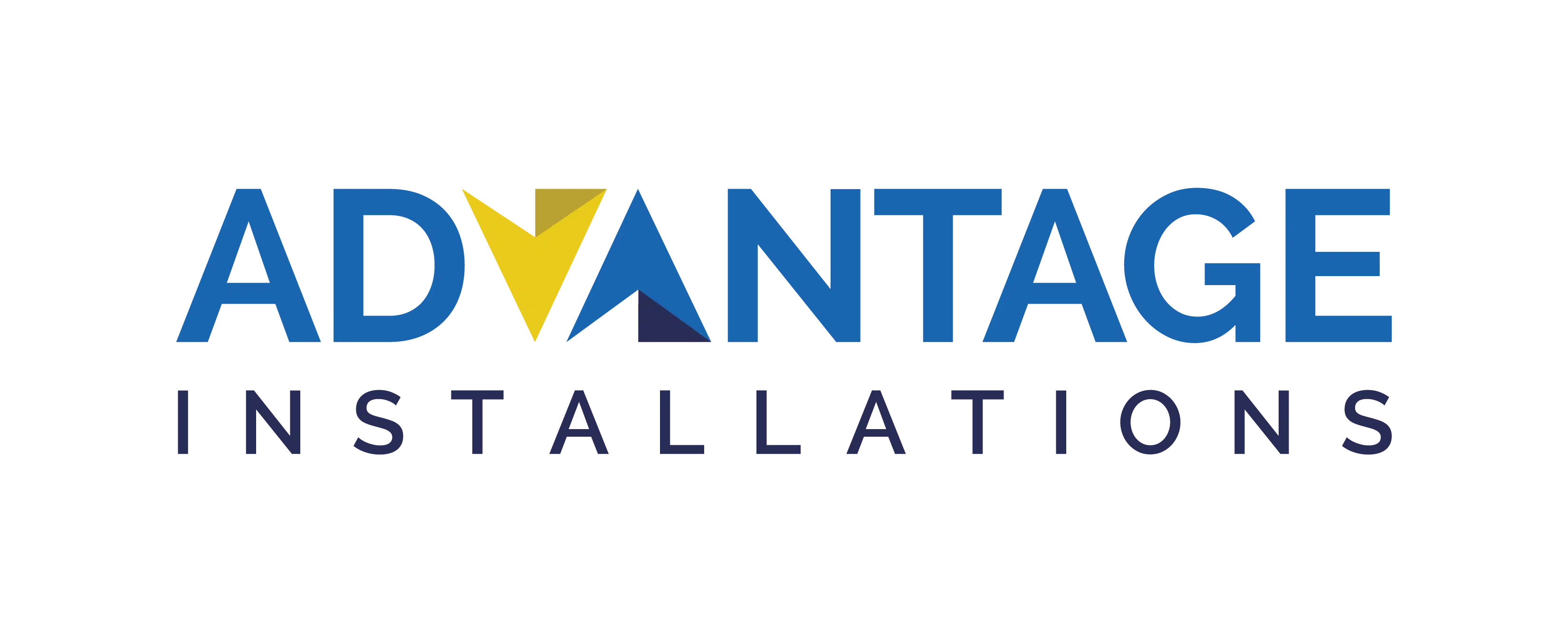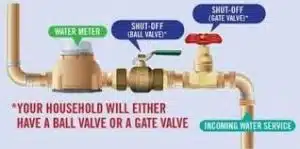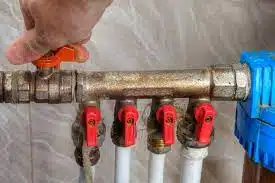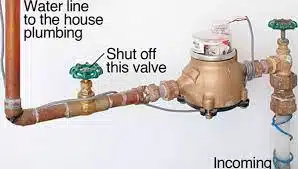EDMONTON EMERGENCY PLUMBING
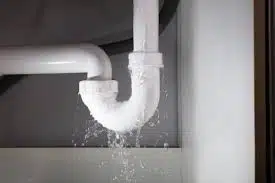
When there are leaks and water issues in our dwellings, it can feel pretty alarming and be a plumbing emergency very quickly. The pressure in an Edmonton residential water line can cause an overwhelming amount of water to come out in a very short period of time. This can cause extensive damage and be a costly fix.
The plumbing emergency department at Advantage Installations wants to make sure you are prepared ahead of time. This will then hopefully lessen the damage to your dwelling. Call our plumbing emergency staff at Advantage Installations to come help you look the system over and both assess its condition and get you feeling comfortable with it. But if you are facing an emergency right now; the first thing to do is turn off your water shut off valves or your main water supply. Don’t know where these are? Call us at 780 413 6380
Avoid a plumbing emergency
To get started, you need to make sure all of your water fixtures have shut off valves under them or between where they connect from the fixture, to the water supply. What are fixtures? Toilets, sinks, taps, washing machines, outdoor taps and bath tubs/showers etc… Remember that sinks or fixtures with a hot and cold will generally have 2 valves to turn off. If you cannot find a shut off valve for your plumbing fixtures, give us a call and we can help install them for you. This is often true in older homes. It isn’t an expensive job or fix but it will be a lifesaver when leaks or issues occur.
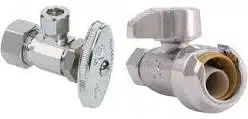
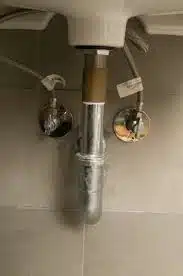
To turn off the valve, turn it clockwise. Usually when it is horizontal, it should be closed. But if not, try turning it the other way. The water should stop running. If this hasn’t helped and the water is still running, it is time to find the main shut off valve for your house.
Leaking
Sometimes for bathtubs and showers, the shut off valves are not accessible. The water connections are all contained behind the walls. Leaks can also come in the lines before the shut off valves as well. You will need to know how to react when the leak is in a pipe or connection further back in the line. This leads to your second step.
Emergency shut off valve
Make sure you know where your main water shut off is. This can usually be found near an exterior wall where your water comes into your house. Here are a few examples of what to look for.
This main valve is usually in your mechanical room or close to your hot water tank. In a condo or apartment you may find it in the bathroom or under the kitchen sink. Best to ask your building maintenance manager ahead of time if you are not sure. To shut off the water supply, turn off the valve located before the meter clockwise. Edmonton meters are usually located in the basement, but they can also be found in the crawl space or the main floor.
Plumbing maintenance
Be sure that your main valves are working and functioning well. Look for corrosion or rust. If they need to be changed, do it ahead of time. Test all of your shut off valves on a yearly basis. Contact us if any of them need replacing.
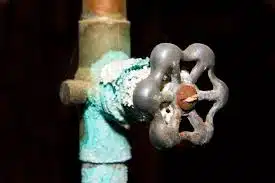
When you are heading out on an extended vacation, it is usually a good idea to turn your water off at your main shut off valve. This way if there is a leak, damage will be minimal.
Regularly watch for leaks and do visual checks. How do you know if you have a water leak if you can’t see it? The answer is as simple as keeping an eye on your water meter. Choose a time when no water will be used for a period of at least two hours and take note of the reading before and after. If the meter moves, you probably have a water leak.
Once you have found all of the shut off valves, make sure every responsible person in your house knows their location and how to use them in case of an emergency.
Have new fixtures, taps and valves installed by the professionals at Advantage Installations. They can ensure that everything is running smoothly and set up correctly.
Plumbing emergency correction!
First locate where the leak is occurring. It may be further back than you think. Water can run for a long ways, travelling always to the lowest point. Turn off any shut-off valves that might help. If you can’t turn off the water this way go to your main shut off valve and turn it off. It might be coming from a leak in your roof or attic too, in which case you will need to call some roofing experts. It might be tricky to find the source of the leak.
Next; Clean up the water as quickly as you can with towels, rags, mops, wet vacs, pumps or pails. Turn on fans directed at where the leak was. Run a dehumidifier in that area.
Then; Call us to come help you fix the problem or get at the source of the issue. We can help you figure out what to do after that. Depending on any damage or issues that might linger after the leak has been fixed.
To request an appointment with us, call us at 780 413 6380 or contact us on-line through our Get a Quote page.
FAQS: Plumbing Emergencies
What is considered a plumbing emergency?
- A plumbing emergency is any situation where water damage is likely to occur or has already begun. This includes burst pipes, severe leaks, clogged drains, overflowing toilets, and inoperable water heaters. If left unaddressed, these issues can lead to extensive property damage and costly repairs.
How do I know if I have a burst pipe?
Signs of a burst pipe include sudden drops in water pressure, water stains on walls or ceilings, unusual sounds coming from the plumbing, and unexpected water bills. If you experience any of these, it’s important to contact a plumber immediately to prevent further damage.
What should I do if my toilet overflows?
If your toilet overflows, turn off the water supply to the toilet using the shut-off valve located behind it. Remove the tank lid and ensure the flapper is closed to stop water from entering the bowl. Once the water flow is stopped, try using a plunger to clear the blockage. If the problem persists, it’s best to call a professional plumber.
How can I prevent plumbing emergencies?
Regular maintenance is key to preventing plumbing emergencies. This includes inspecting pipes for leaks, ensuring drains are clear, not flushing inappropriate items down toilets, and making sure your water heater is functioning properly. Scheduling routine check-ups with a professional plumber can help spot potential issues before they become emergencies.
Why is my water heater not working?
If your water heater isn’t working, it could be due to a variety of issues such as a faulty thermostat, broken heating element, or sediment build-up. Check the pilot light if you have a gas heater. If you’re unable to identify the problem, contact a plumber for a thorough inspection and repair.
Can I fix a plumbing emergency myself?
While some minor plumbing issues can be resolved with DIY methods, many emergencies require professional expertise to ensure safe and effective repairs. Attempting to fix major problems on your own can lead to further damage and increased repair costs. It’s always advisable to contact a licensed plumber for emergencies.
How quickly can a plumber arrive during an emergency?
Response times can vary based on location and current demand, but most plumbing services strive to respond as quickly as possible, typically within an hour for emergencies. When you contact a plumber, they should be able to give you an estimated arrival time.
What should I do while waiting for the plumber?
While waiting for the plumber, try to minimize water damage by shutting off the main water supply if possible. Collect leaking water in a bucket to prevent flooding, and clear the area of any belongings that may be at risk of water damage. Avoid using any affected plumbing fixtures until the issue is resolved.
